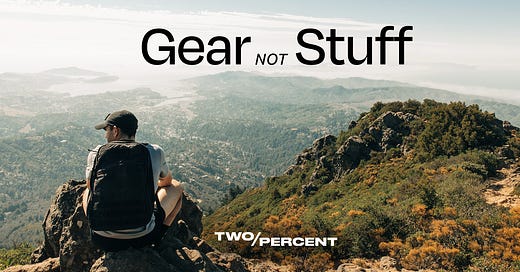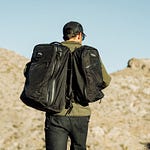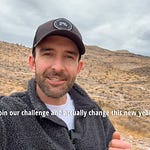Post summary
We tend to be less active in winter because of cold temperatures—and that hurts our metabolic and mental health.
But the problem isn’t the cold. The problem is gear. We often don’t know the right outdoor exercise apparel and how to layer it as a system to stay warm and dry.
This post covers seven laws of winter exercise gear and teaches you how to build the perfect system.
I also reveal my seven favorite pieces of cold-weather exercise gear.
The result: You’ll exercise outside more this winter, which will help you stay healthy and fit, avoid winter blues and weight gain, and even sleep better.
Housekeeping
Full access to this post and its video and audio is for Members of Two Percent.
Become a Member below to get full access to this post and the Two Percent community.
Thanks to our partners, who make the best products in their categories.
GOREWEAR: Maker of cutting-edge, science-backed endurance apparel that performs no matter what nature throws at you. Their gear has the official “Have Fun, Don’t Die” seal of approval. Check out the Concurve Jacket.
Discount code EASTER30 for 30% off.
I’ve also included a note on Two Percent’s partnership policy below.
Audio/podcast version
The post
Today is the second Friday of the month. Which means it’s time for Gear Not Stuff.
The concept for Gear Not Stuff is simple.
We live in a world of mass consumerism and have more stuff than ever. As my book Scarcity Brain explained, the average home contains 10,000 to 50,000 items.
If we want a new thing, we no longer have the pause of traveling to a store—we can buy it right from our computer, phone, TV, or even yell to Alexa.
We own too much, and curious forces are now leading us to acquire even more stuff …
Consider: Online retailers stole tactics from casinos, leading us to buy more faster. They leverage what’s called The Scarcity Loop. It’s worked on you if you’ve ever bought some crap and immediately regretted buying said crap. More on the power of The Scarcity Loop here.
When we get overwhelmed by how much we own, we often seek minimalism.
But minimalism has failed us (I covered why in Scarcity Brain). Luckily, I found a smarter way we can get more from less …
In thinking about how we can make smarter purchasing decisions, I’ve begun delineating between gear and stuff.
Stuff is a possession for the sake of it. Stuff adds to a collection of (too many) items. We often buy stuff impulsively to fix boredom or stress or to solve a problem we could figure out creatively with something we already have.
Gear, on the other hand, has a clear purpose of helping us achieve a higher purpose.
Gear is a tool we can use to have better experiences that make us healthier and give our lives meaning.
Enter Gear Not Stuff, a monthly column featuring the best gear.
This month’s Gear Not Stuff: Cold weather exercise gear
Fifty-eight percent of people become less active during the winter. That reduction in activity can lead to:
Winter weight gain (the weight in most people increases in the winter and stays stable in the summer, leading to a slow increase over time).
Metabolic issues.
Mental health problems like sadness, anxiety, irritability, etc rise. We call this “the winter blues,” or seasonal affective disorder.
The solution is right outside our door—the road, sidewalk, or trail we can run, cycle, ruck, or walk on.
If you stay active outdoors this winter, you’ll maintain better metabolic health, fight back against weight gain, and avoid the winter blues.
In truth, the problem isn’t actually the cold. Even just a few hundred years ago, many people lived outside 24/7. They worked hard outside daily regardless, of the cold. The idea that you’d stop being active outside just because it’s a bit nippy is very new.
The problem is twofold:
Our temperature comfort zones have become very narrow, and we now have a harder time tolerating the cold.
We often don’t know the best practices for dressing in the cold. Not knowing how to build a good cold weather gear system leads to getting too cold, having a miserable experience, and stopping outdoor exercise in winter. At worse, it can put us in a dangerous position with frostbite and hypothermia.
This post is about point two. And the good news is that once you figure out point two, you’ll be able to spend more time outside, helping you slowly adapt to the cold and solve point one.
This post and its video cover:
Seven laws for building a perfect system that will keep you warm and safe as you exercise outdoors this winter.
My favorite cold-weather exercise gear.
The result: You’ll learn how to use the gear you already have better. And if you need new gear, you’ll know the best in the game.
Follow this advice to exercise outside well and often this winter so you can outlast and outwork all the poor, tortured souls chained to sofas and treadmills.
The rules for exercising in cold weather
1. Stay dry
Let’s say you were to step outside on a 40-degree day. It would be a bit uncomfortable, but you’d be fine for a while.
Jumping in a 40-degree tub of water, however, would be truly awful. Cold water is so much colder than air.
The reason: Water has a greater thermal capacity than air. Its convective heat transfer is 70 times greater.
This is why staying dry is so important. If you get wet or overly sweaty, that water cools and sucks away your heat—and you can find yourself dangerously cold.1
But, a conundrum: Exercise leads to sweat, which is water. Here’s how you deal …
2. Wear wool or synthetic base layers (not cotton!)
Cotton is 100 percent hydrophilic, meaning it retains moisture. When it gets wet, it holds water. Then that water gets cold—and becomes a sort of cooling death blanket that can lead to hypothermia.
Wool and synthetic layers, on the other hand, pull moisture away from your body and lead it to evaporate faster, keeping you dryer and warmer.
This is why your first layer should be thin and made of wool or synthetic fabric.
Wool is generally warmer and manages body odor, but it’s less durable, more expensive, and doesn’t dry as quickly.
Synthetic is generally cheaper, dries quicker, and is more durable but can retain odor (I’ve found stuck odor is more of an issue in humid climates).
3. Insulate yourself
An insulating layer is the second part of your cold-weather exercise system. Think of a thin puffy jacket or vest. Its job is to trap your body heat while pulling moisture away from your skin. A few rules for this piece:











